Did you know that 42-45% of marriages end in divorce?
That’s not the most pleasant statistic to start off this article with but hear me out.
Family law is a massive industry.
Heck, if you’re doing well in any legal industry then you’re practically set for life.
However, that doesn’t mean you can just kick back and wait for the family law leads to roll in automatically.
You have to market your firm like any other business if you want nonstop clients.
That’s why today I’m going to show you family law firm marketing strategies that will have your phone ringing all day.
What is family law?
Family law is an area of law regarding marriages, divorces, children, and the related responsibilities for the parties involved in family disputes.
This also includes child custody, alimony, who retains what property during a separation, adoptions, and more.
Family law firms are businesses which help couples settle disputes related to these issues.
It’s a rapidly growing industry which means that there are more opportunities than ever as a firm to land new clients.
Next, I’m going to touch on tactics family law attorneys and firms can use to increase brand awareness, authority, and leads.
Family law marketing strategies
Implement one or several of the following strategies to begin growing your firm faster. The below techniques all synergize together, so it’d be wise to use them in conjunction for the best results.
Family law content marketing
82% of consumers feel more positive about a business after reading custom content from them.

Content helps you educate readers about relevant topics on family law, attract clients to your website organically, and position your firm as a thought-leader.
It remains as one of the best long term strategies for any attorney as it’s becoming increasingly obvious of its benefits.
Content marketing also takes little to no budget.
All you need to do is hire a content writer like myself and 90% of the work will be done for you.
The copywriter will research topics, SEO keywords, and produce articles which will eventually rank highly on Google.
High-quality users will come to your website, become educated on family law subjects, and will contact you if they need your services.
It serves as the foundation of the other strategies I’ll be speaking about later today, too.
Here are the three steps you need to follow for executing an effective content marketing strategy.
Step 1: Decide on a single format to begin
While you can eventually branch out into various content formats, which I’ll be touching on in a moment, it’s best to choose one to focus on first.
I always recommend blogging because odds are you already use a content management system like WordPress, Wix, or Weebly.
It has a much lower barrier to entry compared to producing high-quality videos, for example.
Blogging is also the best way to increase organic traffic to your website.
It’s been found that those who publish 6-10 articles a month or more see the most traffic improvements.
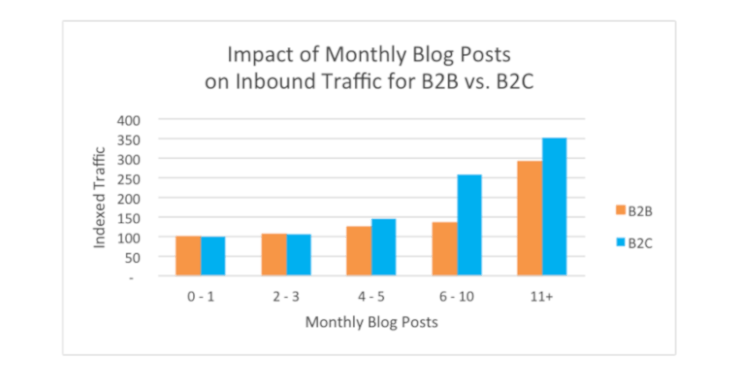
This means that it’s best if you publish approximately two to three articles per week.
That brings me to my next point.
Step 2: Brainstorm topic ideas your clients care about
What problems do your clients face? What questions do they most often ask? What topics would help them with their situations?
The answers to these questions will act as the foundation of your content marketing strategy.
Remember that the ultimate goal is to bring hyper-relevant users to your website, educate them on relevant subjects, and get them into your sales funnel.
While you can use your noggen to come up with ideas, I also recommend snooping on competitors to see what they’re doing.
Do a Google search for family law attorneys in your area and find their blog.
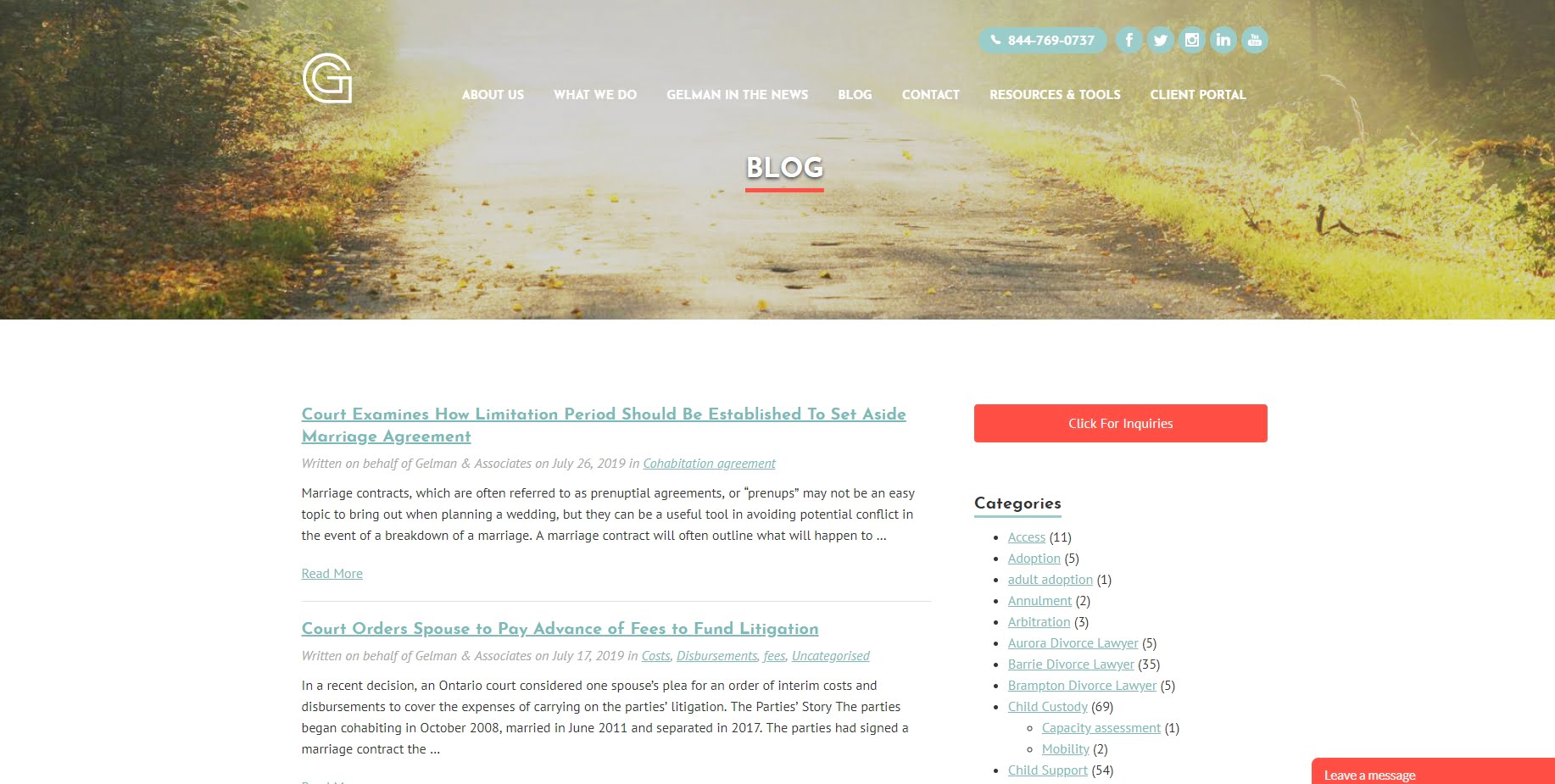
Note any ideas you have for blog posts based on the topics they cover.
You should make a spreadsheet to organize your findings, too. This is what we call a content calendar.
It maps out the content you plan to produce for the upcoming month with topics, keywords, format, and other information laid out.
In the case you hire a copywriter like myself, you can share this with them to give them all of the information they need to get started.
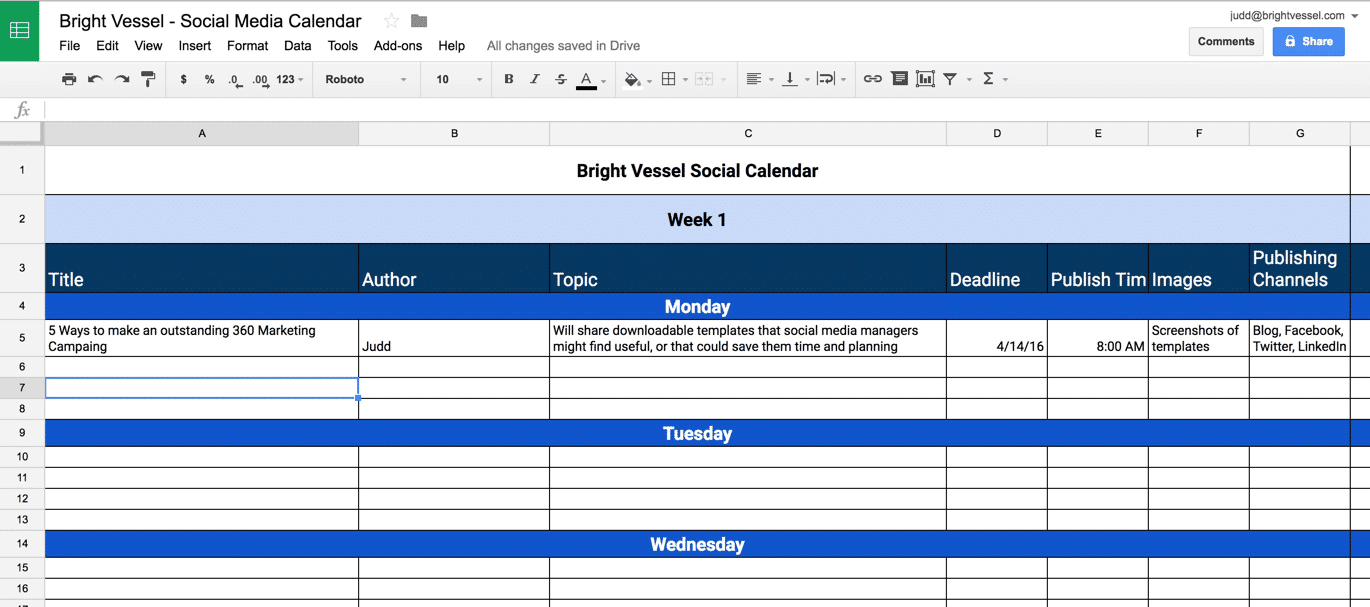
You can then move onto the fun part of content marketing after this planning stage: writing the content!
Step 3: Publish and promote!
The next step is to create the content itself which is easier said than done. However, I’m going to save you years of learning with the next couple of tips.
Great content is universal. What I mean by this is that there are certain principles you can apply to an article to make it amazing. These include:
- Long-form is in: You can’t publish 500 word blog posts and expect to see amazing results. It won’t help you rank on Google nor provide enough value to readers. That’s why I recommend firms to write 1,000 words and beyond. This is more than enough room to provide strategies, advice, tools, and resources.
- Make it practical: A reader should come to your blog, consume a post, and know exactly what to do next to solve their problem. This is why you need to make every article you publish actionable. Lead them step-by-step through instructions, show them how to use online tools, and give them extra resources like cheat sheets.
- Add visuals: Blog posts are newspapers. That means you need to avoid big blocks of text without any form of media. Images, graphics, and videos add more depth to your content and make it more visually appealing.
Follow those three tips and you’ll produce better content than 9/10 firms you compete with. I guarantee it.
Once you publish your blog post, it’s time to kick back, right?
Not yet!
It’s now time to promote your content.
Sure, good SEO which you’ll learn next will boost organic traffic but you need to get it in front of an immediate audience in the meantime.
This is why you need to promote blog posts on social media and content syndication websites.
I‘m a big advocate of using Facebook and LinkedIn groups because they allow you to reach a larger userbase instantly.
You can search for terms like “Family law” on Facebook, switch to the groups tab, and join as many communities as you wish.

You can then have your social media team publish content in these groups and remain active to build a good reputation.
Similarly, you can go use LinkedIn Groups to find these types of communities.
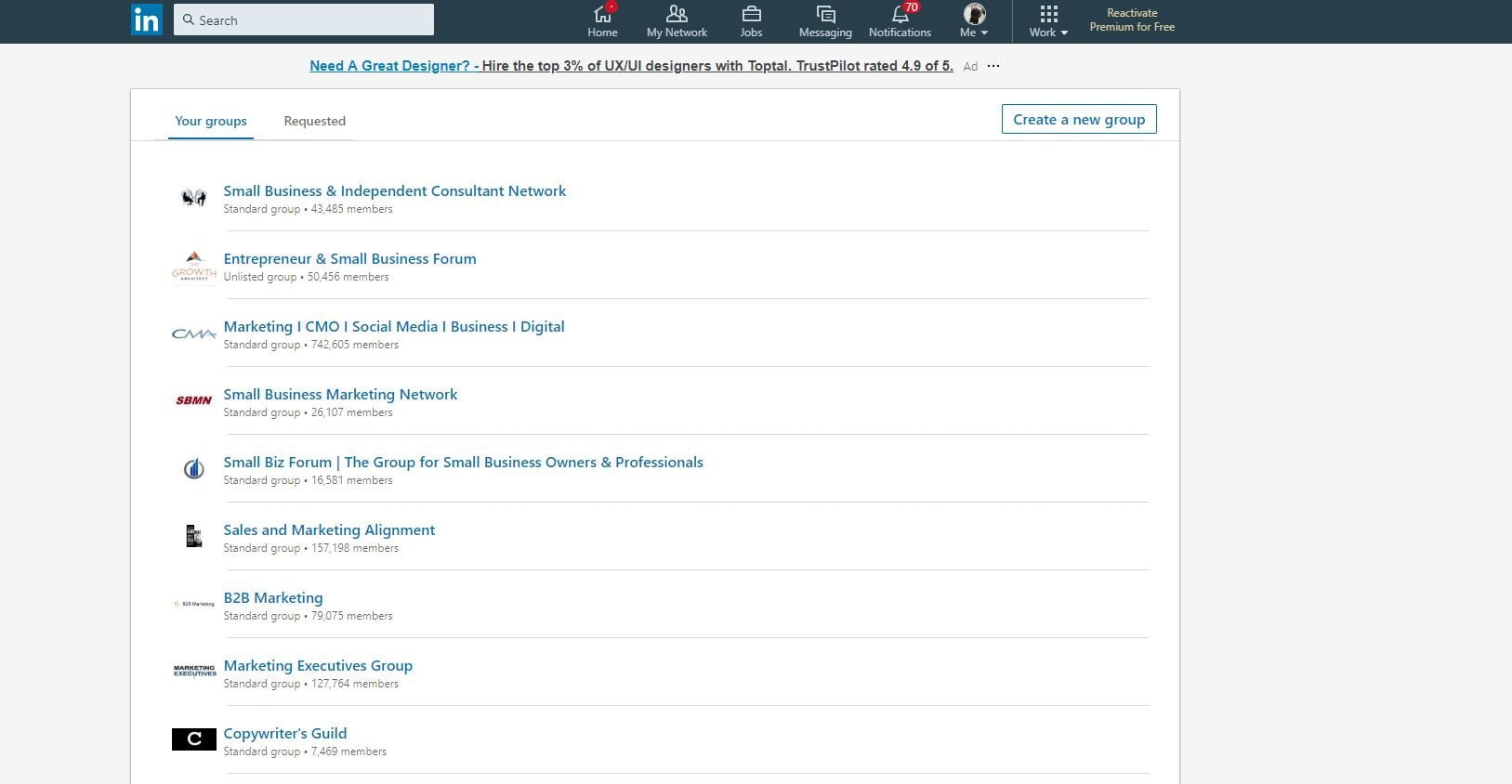
The key is to engage with other users in these groups and improve trust before sharing content otherwise it looks like spamming.
Let’s move onto the next family law marketing tactic now.
Family law SEO
Search engine optimization is the process of creating web pages that align with Google’s algorithm.
Here’s a great explanation of what SEO is and why it matters:
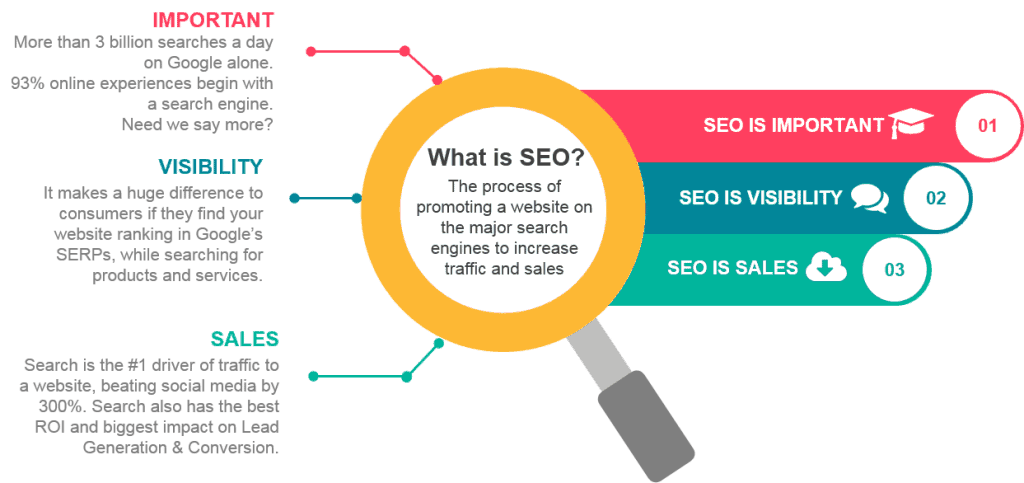
Doing your SEO properly improves how easily your website gets indexed, how high you rank for search terms, and ultimately the traffic you generate.
Understanding the fundamentals of SEO is more than enough for family law firms and attorneys.
There are two parts of SEO you need to grasp: on-page and off-page. Let’s begin with the first.
Optimize on-page elements
On-page SEO is the process of optimizing pages, blog posts, and other elements that are found on your website.
These play a huge role in how well you rank in search engines and most are set-and-forget.
That means you can do it once and reap the benefits over time without touching it again.
I’d like to break down on-page SEO further into two sections: your website itself and individual blog posts.
Optimizing your website
The optimizations you make for your family law website can be done once and audited on a quarterly basis or whatever your marketing department finds fit.
Many of the adjustments you have to do only have to be done once.
These include the following…
Page speed
How fast your website loads has a direct impact on user experience. It’s been proven that slower websites have higher bounce rates which means more people leave before visiting other pages.
Page speed is also a ranking factor Google considers since they want to give their users the best results. See how that works?
If your website is slow, you’re probably missing out on heaps of clients. You’re also negatively affecting how you rank in the SERPs.
Use a free tool like GTmetrix to determine your page speed, size, and if there are any major errors you can fix.
Begin by entering the URL of your website and clicking the “Test your site” button.

It will analyze your domain and display results like the following:
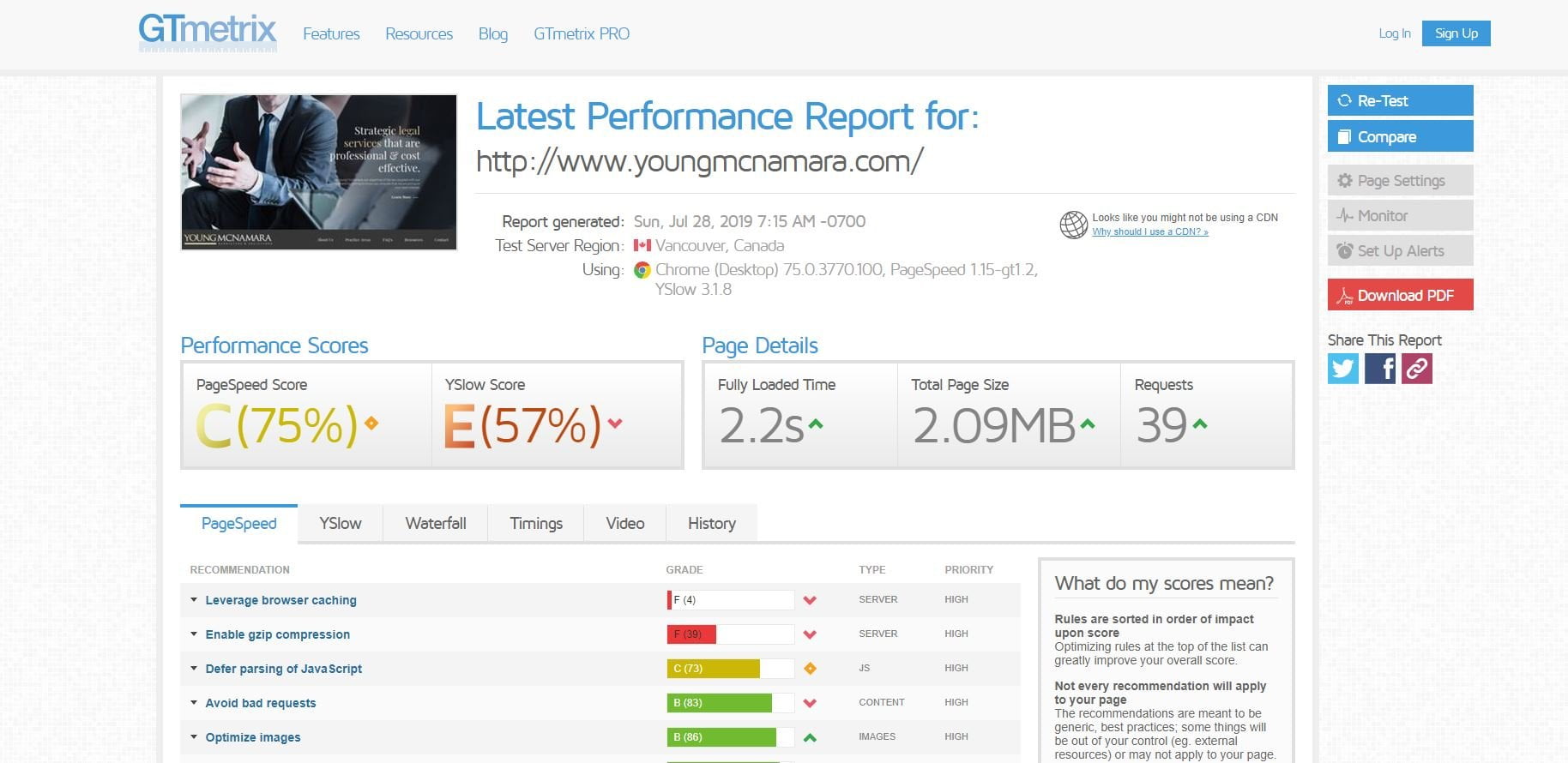
The PageSpeed Score, YSlow Score, and load time are the import metrics here.
Receiving great scores and a load time below two seconds is ideal. GTmetrix will tell you what areas of your site you can improve upon in the bottom sheet.
Hand this information off to your IT team or service provider to fix them.
Navigation
Users need to find what they want on your website quickly or you risk the chance of them becoming frustrated and leaving.
Additionally, good website navigation helps push authority into inner pages.
The first navigation to optimize is your main menu at the top of your website. You should have links to all of the important pages of your website and dropdown menus if needed.
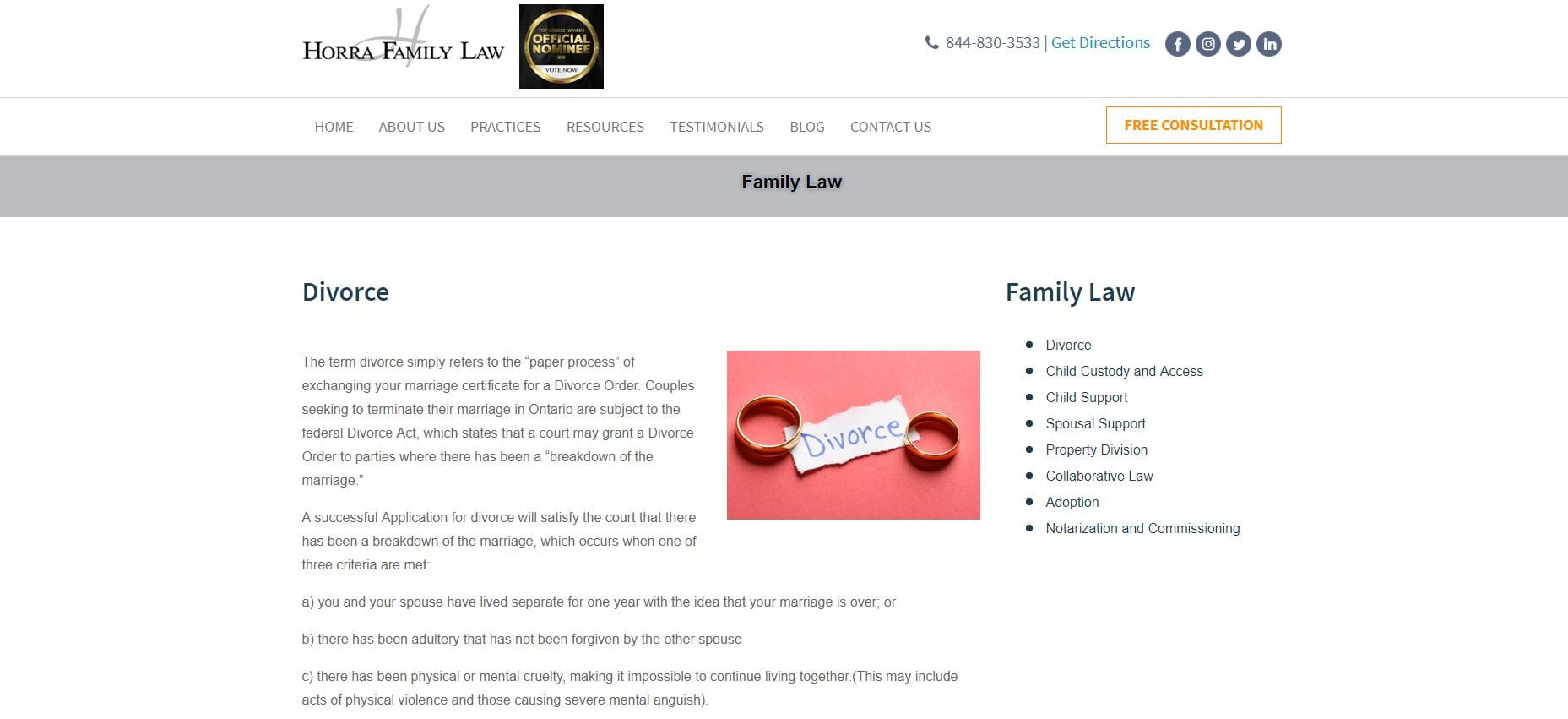
Dropdown menus are beneficial because you can include more inner pages as resources and it helps Google’s index spiders index them quicker.
Next is the footer navigation which appears at the bottom of your website.
Here you want to include all of the major pages on your website along with policies, social media links, and contact information.

Once you’ve achieved this, you can move onto optimizing individual blog posts.
Optimizing your content
Improving page speed, navigation, and similar aspects of your website are one-and-done strategies.
Once you do them, you’ll almost never have to touch them again which is great.
However, regularly publishing content will require you to optimize each article.
Don’t worry, though. I’ve spent years executing content marketing and SEO, so I’m going to share my personal blueprint with you to ensure every blog post crushes it in the SERPs.
Every blog post needs to meet the following criteria:
- Word count: Articles should ideally be around the 1,500-2,000 word range. Long-form content ranks higher and provides more value for readers.
- Title tag: Optimize the title tag to be descriptive and include a search time.
- Meta description: Create an enticing meta description which includes a keyword and optionally a call to action.
- Media: Add videos, graphics, and images to make content more entertaining and valuable.
- Formatting: Use header tags, lists, and bullet points to break up content into digestible pieces.
- URL: Keep the URL short and sweet. If you can add a keyword here, that would be ideal.
- Linking: Add links to other pages on your website and external sources to back up points you make.
- Keyword density: Use your main search term approximately three or four times. Ensure that you add secondary and related keywords to the article, as well.
It’s really as simple as that. Don’t overcomplicate it.
Odds are that your digital marketing team already knows how to clean up all of these things.
Make sure that you or your marketing team has a process in place like this before every article is published.
Execute backlink building campaigns
With on-page SEO out of the way, now we can talk about off-page which mostly consists of building backlinks.
Backlinks are simply links that point to your firm’s website.
It works like a voting system telling search engines which sites are the most useful and liked.

I’ve always advised businesses to obtain natural links because of a lot of link building tactics break Google’s terms of service.
That means you’re likely to get penalized and ruin your website’s performance in the long term.
However, you can avoid this by creating awesome content and promoting it.
You will naturally acquire backlinks as other webmasters link to your great resources.
I would also suggest that you invest in guest posting. This is the strategy of posting articles on other websites.
Often they allow a link back to your website in the biography section which also drives referral traffic and gets your firm seen across the web.
You don’t gain those kinds of benefits with any other form of backlink building.
Final thoughts
The family law industry is one of the most profitable niches to enter as an attorney.
However, more firms are popping up left, right, and center.
That means you need to step up your marketing if you wish to get clients before they run to competitors.
The first technique you need to execute is content marketing. This will bring clients to you without lifting a finger while appearing more authoritative over other firms.
Publish content answering questions your customers would ask and educate them on family law matters.
Those who are in need of services will reach out to you after consuming content.
It’s also wise to promote content on social media to generate immediate traffic and traction.
Family law firms also need to double down on SEO to improve search engine rankings.
Optimize your page speed, navigation, and apply an on-page blueprint to content you publish.
Gradually build backlinks through guest posting and naturally acquiring them, and you will eventually be the top firm in your area without a doubt.
What’s your #1 family law marketing idea?














